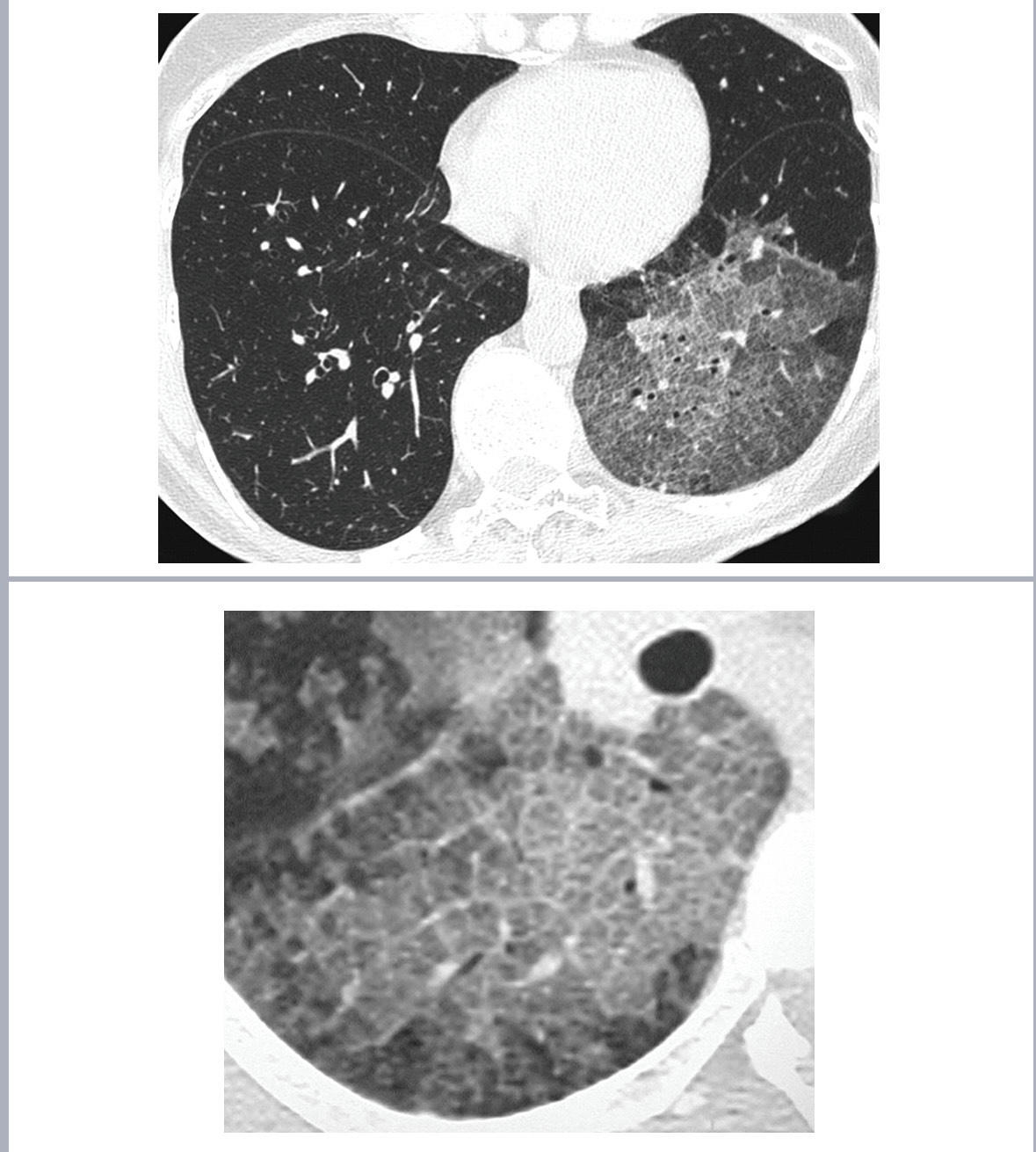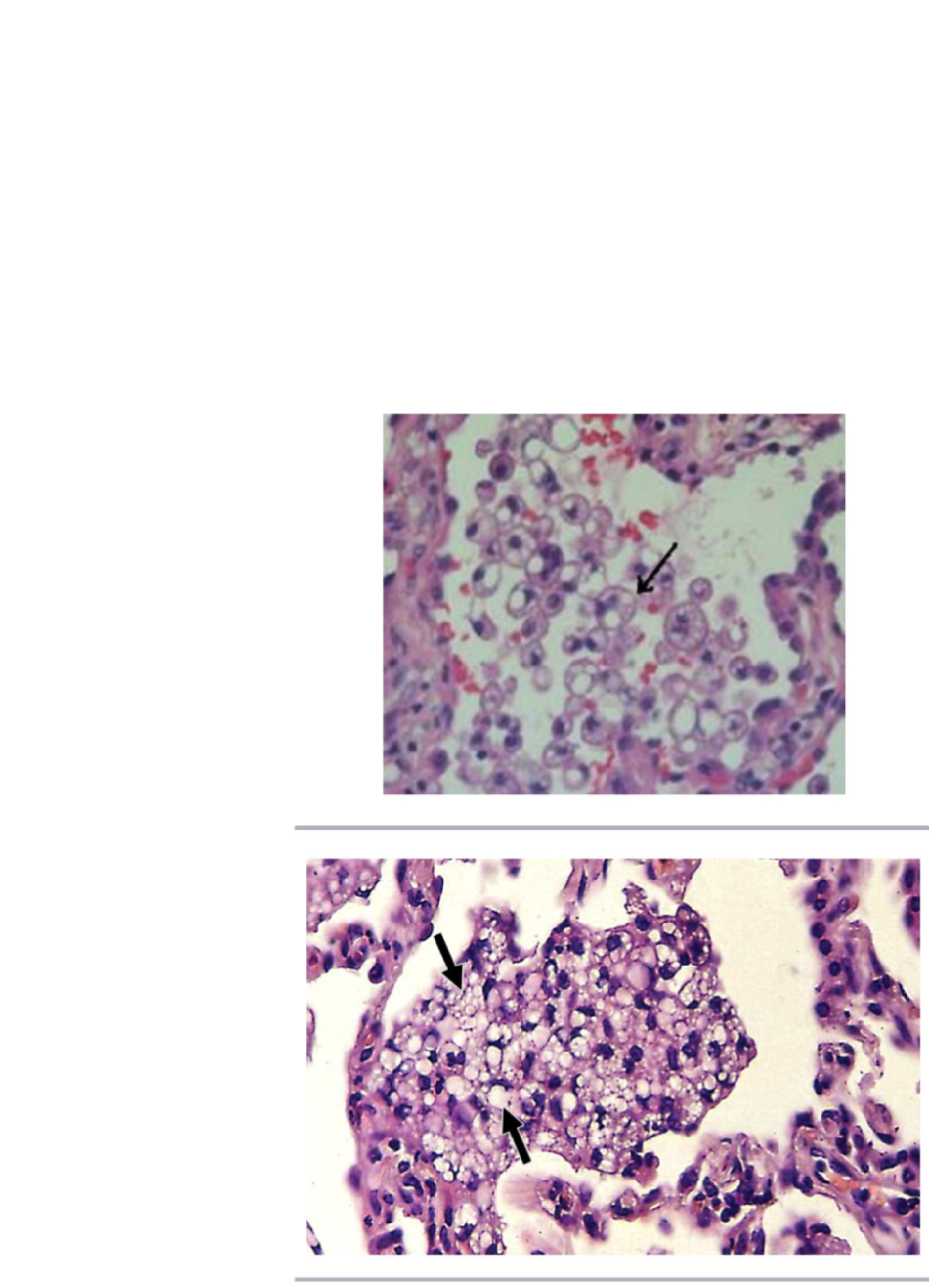Monday Poster Session
Category: Esophagus
P2853 - Silent Aspiration: A Rare Case of Lipoid Pneumonia Linked to Chronic GERD
Monday, October 27, 2025
10:30 AM - 4:00 PM PDT
Location: Exhibit Hall
- HH
Helai Hussaini, MD (she/her/hers)
west anaheim medical center
Anaheim, CA
Presenting Author(s)
Helai Hussaini, MD1, Anooshirvan Hami, MD1, Olaniyi Fadeyi, MD2
1west anaheim medical center, Anaheim, CA; 2West Anaheim Medical Center, Anaheim, CA
Introduction: Lipoid pneumonia is a rare lung condition which is characterized by the accumulation of lipid-laden macrophages in the alveoli. While typically caused by aspiration of oil-based substances, chronic microaspiration from untreated GERD is an infrequent cause. Due to nonspecific symptoms and imaging findings, diagnosis is often delayed. This case highlights the importance of considering GERD-related aspiration in patients with unexplained chronic lung disease.
Case Description/
Methods: A 72-year-old woman with a history of childhood asthma and untreated GERD presented with a 2- to 3-day history of intermittent hemoptysis, progressively worsening dyspnea, and cough. Eighteen months earlier, she was hospitalized with similar symptoms and diagnosed with presumed viral pneumonitis; she was discharged on supplemental oxygen for persistent hypoxia, but she continued to experience a daily cough, which she attributed to asthma.
On this admission, she was found to be hypoxic (SpO2 88% on RA), tachypneic, with diffuse fine crackles on lung exam. Chest CT showed progression of bilateral interstitial infiltrates compared to prior imaging. Autoimmune screening,viral and fungal serologies were unremarkable. Bronchoscopy revealed diffuse erythema without focal bleeding, and bronchoalveolar lavage was negative for infectious pathogens and malignancy.
Due to the clinical deterioration, she was admitted to the ICU and intubated. An open-lung biopsy revealed numerous lipid-laden macrophages, multinucleated foreign-body giant cells, and mild interstitial chronic inflammation with fibrosis. Special stains were negative for acid-fast bacilli and fungi, ruling out TB and fungal infections. She denied exposure to oil-based substances. Chronic GERD-related microaspiration was considered the likely etiology in this case.
Subsequently, patient was treated with intravenous antibiotics, corticosteroids, and PPI. She improved significantly, was successfully extubated, and continued to recover with optimized reflux management and supportive pulmonary care.
Discussion: GERD-related microaspiration is an overlooked etiology of exogenous lipoid pneumonia. Repeated inhalation of gastric contents containing lipids leads to accumulation of lipid-laden macrophages in the lungs, triggering inflammation and fibrosis. Unlike classic lipoid pneumonia from oil ingestion, GERD-associated cases develop gradually and silently. Early diagnosis and treatment, including acid suppression and steroids, can improve outcomes and prevent lung damage.

Figure: Top image: Axial CT chest revealing right lower lobe ground glass opacities with interlobular septal thickening, forming crazy- paving pattern
Bottom image: magnified CT image highlighting the crazy-paving pattern suggestive of alveolar and interstitial involvement in lipoid pneumonia

Figure: Top image: H&E stain demonstrating lipid-laden foamy macrophages within alveolar spaces
Bottom image: high-power view showing clusters of vacuolated macrophages with intracytoplasmic lipid droplets, consistent with exogenous lipid pneumonia.
Disclosures:
Helai Hussaini indicated no relevant financial relationships.
Anooshirvan Hami indicated no relevant financial relationships.
Olaniyi Fadeyi indicated no relevant financial relationships.
Helai Hussaini, MD1, Anooshirvan Hami, MD1, Olaniyi Fadeyi, MD2. P2853 - Silent Aspiration: A Rare Case of Lipoid Pneumonia Linked to Chronic GERD, ACG 2025 Annual Scientific Meeting Abstracts. Phoenix, AZ: American College of Gastroenterology.
1west anaheim medical center, Anaheim, CA; 2West Anaheim Medical Center, Anaheim, CA
Introduction: Lipoid pneumonia is a rare lung condition which is characterized by the accumulation of lipid-laden macrophages in the alveoli. While typically caused by aspiration of oil-based substances, chronic microaspiration from untreated GERD is an infrequent cause. Due to nonspecific symptoms and imaging findings, diagnosis is often delayed. This case highlights the importance of considering GERD-related aspiration in patients with unexplained chronic lung disease.
Case Description/
Methods: A 72-year-old woman with a history of childhood asthma and untreated GERD presented with a 2- to 3-day history of intermittent hemoptysis, progressively worsening dyspnea, and cough. Eighteen months earlier, she was hospitalized with similar symptoms and diagnosed with presumed viral pneumonitis; she was discharged on supplemental oxygen for persistent hypoxia, but she continued to experience a daily cough, which she attributed to asthma.
On this admission, she was found to be hypoxic (SpO2 88% on RA), tachypneic, with diffuse fine crackles on lung exam. Chest CT showed progression of bilateral interstitial infiltrates compared to prior imaging. Autoimmune screening,viral and fungal serologies were unremarkable. Bronchoscopy revealed diffuse erythema without focal bleeding, and bronchoalveolar lavage was negative for infectious pathogens and malignancy.
Due to the clinical deterioration, she was admitted to the ICU and intubated. An open-lung biopsy revealed numerous lipid-laden macrophages, multinucleated foreign-body giant cells, and mild interstitial chronic inflammation with fibrosis. Special stains were negative for acid-fast bacilli and fungi, ruling out TB and fungal infections. She denied exposure to oil-based substances. Chronic GERD-related microaspiration was considered the likely etiology in this case.
Subsequently, patient was treated with intravenous antibiotics, corticosteroids, and PPI. She improved significantly, was successfully extubated, and continued to recover with optimized reflux management and supportive pulmonary care.
Discussion: GERD-related microaspiration is an overlooked etiology of exogenous lipoid pneumonia. Repeated inhalation of gastric contents containing lipids leads to accumulation of lipid-laden macrophages in the lungs, triggering inflammation and fibrosis. Unlike classic lipoid pneumonia from oil ingestion, GERD-associated cases develop gradually and silently. Early diagnosis and treatment, including acid suppression and steroids, can improve outcomes and prevent lung damage.

Figure: Top image: Axial CT chest revealing right lower lobe ground glass opacities with interlobular septal thickening, forming crazy- paving pattern
Bottom image: magnified CT image highlighting the crazy-paving pattern suggestive of alveolar and interstitial involvement in lipoid pneumonia

Figure: Top image: H&E stain demonstrating lipid-laden foamy macrophages within alveolar spaces
Bottom image: high-power view showing clusters of vacuolated macrophages with intracytoplasmic lipid droplets, consistent with exogenous lipid pneumonia.
Disclosures:
Helai Hussaini indicated no relevant financial relationships.
Anooshirvan Hami indicated no relevant financial relationships.
Olaniyi Fadeyi indicated no relevant financial relationships.
Helai Hussaini, MD1, Anooshirvan Hami, MD1, Olaniyi Fadeyi, MD2. P2853 - Silent Aspiration: A Rare Case of Lipoid Pneumonia Linked to Chronic GERD, ACG 2025 Annual Scientific Meeting Abstracts. Phoenix, AZ: American College of Gastroenterology.
